
Trakehner is a light warmblood breed of horse, originally developed at the East Prussian state stud farm in the town of Trakehnen from which the breed takes its name. The state stud was established in 1731 and operated until 1944, when the fighting of World War II led to the annexing of East Prussia by Russia, and the town containing the stud renamed as Yasnaya Polyana.

The Akhal-Teke is a Turkmen horse breed. They have a reputation for speed and endurance, intelligence, and a distinctive metallic sheen. The shiny coat of the breed led to their nickname, "Golden Horses". These horses are adapted to severe climatic conditions and are thought to be one of the oldest existing horse breeds. There are currently about 6,600 Akhal-Tekes in the world, mostly in Turkmenistan, although they are also found throughout Europe and North America. Akhal is the name of the line of oases along the north slope of the Kopet Dag mountains in Turkmenistan. It has been inhabited by the Tekke tribe of Turkmens.

The Cleveland Bay is a breed of horse that originated in England during the 17th century, named after its colouring and the Cleveland district of Yorkshire. It is a well-muscled horse, with legs that are strong but short in relation to the body. The horses are always bay in colour, although a few light hairs in the mane and tail are characteristic of some breed lines. It is the oldest established horse breed in England. The ancestors of the breed were developed during the Middle Ages for use as pack horses, when they gained their nickname of "Chapman Horses". These pack horses were cross-bred with Andalusian and Barb blood, and later with Arabians and Thoroughbreds, to create the Cleveland Bay of today. Over the years, the breed became lighter in frame as they were employed more as carriage and riding horses. The popularity of the Cleveland Bay has greatly fluctuated since it was first imported to the United States in the early nineteenth century. Despite serious declines in the population after the Second World War, the breed has experienced a resurgence in popularity since the 1970s, although only around 550 horses existed worldwide as of 2006.
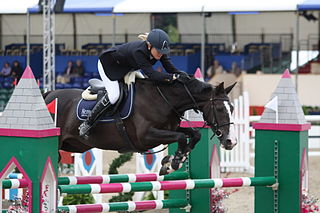
The Selle Français (SF) is a breed of sport horse from France. It is renowned primarily for its success in show jumping, but many have also been successful in dressage and eventing. An athletic horse with good gaits, it is usually bay or chestnut in color. The Selle Français was created in 1958 when several French riding horse breeds were merged into one stud book. The new breed was meant to serve as a unified sport horse during a period when horses were being replaced by mechanization and were transforming into an animal used mainly for sport and leisure.
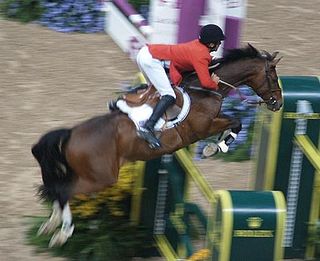
The Holsteiner is a breed of horse originating in the Schleswig-Holstein region of northern Germany. It is thought to be the oldest of warmblood breeds, tracing back to the 13th century. Though the population is not large, Holsteiners are a dominant force of international show jumping, and are found at the top levels of dressage, combined driving, show hunters, and eventing.
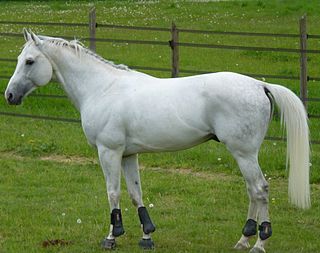
The Anglo-Arabian or Anglo-Arab is a crossbred, part-Arabian horse that now also has its own status as a horse breed. It is the result of a Thoroughbred being crossed with an Arabian. The cross can be made between a Thoroughbred stallion and an Arabian mare, or vice versa. It can also be a cross between either an Anglo-Arab and a Thoroughbred or, alternatively, an Anglo-Arab and an Arabian. Another permitted cross is between two Anglo-Arabians. No matter the cross, a horse must have a minimum 12.5% of Arabian blood to be considered an Anglo-Arabian.

The Russian Don is a breed of horse developed in and named after the steppes region of Russia where the Don River flows. Utilized originally as cavalry horses for the Cossacks, they are currently used for under-saddle work and driving.

The Tersk or Tersky is a Russian breed of light riding horse of Arab type. It was bred at the Tersk Stud in Stavropol Krai in the North Caucasus between about 1925 and 1940.
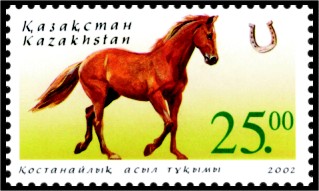
The Kustanair is a breed of horse developed in Kazakhstan in the former U.S.S.R. in the late 19th and early 20th centuries. They are used mainly for under-saddle and light draft work.

The Bavarian Warmblood is a horse breed of southern Germany that developed from an older Bavarian heavy warmblood breed called the Rottaler. Since mechanization in the mid-20th century, the Bavarian Regional Horse Breeders' Society has concentrated on producing a riding horse for the Olympic disciplines and recreational riding based on other European warmblood bloodlines.

The Novokirghiz or New Kirghiz is a modern Kyrgyz breed of horse. It was developed in the Kirghiz Soviet Socialist Republic in the mid-twentieth century through cross-breeding of the traditional Kyrgyz Horse of the region with introduced horses of Thoroughbred, Don and Anglo-Don stock.

The Indian Half-bred is a horse type from the subcontinent of India. It is a cross-breed between Thoroughbred stallions and local and imported mares of various types. It is raised mainly by the Indian Army as a cavalry mount; it is also used by the Indian Police Service, as a polo pony, and for recreational and competitive riding.

The Kazakh Horse is a horse breed of the Kazakh people, who live mainly in Kazakhstan, but also in parts of China, Mongolia, Russia and Uzbekistan. It is used mainly as a riding horse, and is known for its hardiness and stamina.
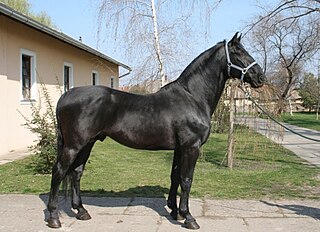
The Nonius is a Hungarian horse breed named after its Anglo-Norman foundation sire. Generally dark in color, it is a muscular and heavy-boned breed, similar in type to other light draft and driving horses. The breed was developed at the Imperial Stud at Mezőhegyes, Hungary by careful linebreeding. Originally bred to serve as a light draft and utility horse for Hungary's military, the breed became a useful agricultural horse during the 20th century. The depredations of World War II significantly reduced the Nonius' population, and in the decades after the war, a downturn in the usage of horses in Hungary sent many members of the breed to slaughter. Today the breed is bred by preservationists and is used in agriculture, leisure riding, and competitive driving sports. The largest numbers of Nonius horses are still found at Mezőhegyes, with representatives in other eastern European nations as well.
An Austrian Warmblood is a warmblood type of horse registered with the Arbeitsgemeinschaft für Warmblutzucht in Österreich. Although the studbook is made up of jumping and dressage horses from many other countries, the mare base consists of native horses with a long history. The AWÖ keeps an open studbook, in which mares and stallions must pass rigorous inspections before becoming breeding stock.
The Tersk Stud is a horse breeding farm, and it was used to restore the Russian horse population, which suffered heavy losses during the 1917-1923 Revolution. It was officially established on 11 February 1921, on the orders of Marshal Semyon Budyonny.

The Anglo-Norman horse is a warmblood horse breed developed in Lower Normandy in northern France. A major center of horse breeding, the area had numerous regional types that were bred to one another and then crossed with Thoroughbreds to form the Anglo-Norman. Various body types developed within the Anglo-Norman breed, two of which were split off to form the Norman Cob and French Trotter. The remaining types were eventually standardized, although there remained some criticism of the "hybrid" nature of the breed's conformation. However, it is successful as an international sport horse, especially in the sport of show jumping. The Anglo-Norman also contributed to the development of several other breeds in Europe and Asia.

The Heck horse is a horse breed that is claimed to resemble the tarpan, an extinct wild equine. The breed was created by the German zoologist brothers Heinz Heck and Lutz Heck in an attempt to breed back the tarpan. Although unsuccessful at creating a genetic copy of the extinct species, they developed a breed with grullo coloration and primitive markings. Heck horses were subsequently exported to the United States, where a breed association was created in the 1960s.

The Norman Cob or Cob Normand is a breed of light draught horse that originated in the region of Normandy in northern France. It is of medium size, with a range of heights and weights, due to selective breeding for a wide range of uses. Its conformation is similar to a robust Thoroughbred, and it more closely resembles a Thoroughbred cross than other French draught breeds. The breed is known for its lively, long-striding trot. Common colours include chestnut, bay and seal brown. There are three general subsets within the breed: horses used under saddle, those used in harness, and those destined for meat production. It is popular for recreational and competitive driving, representing France internationally in the latter, and is also used for several riding disciplines.

The Charentais and Vendéen are extinct breeds of horse from western France. They were bred principally in the area around Poitou-Charentes and Vendée, France. They were used as a mount for light cavalry.


















